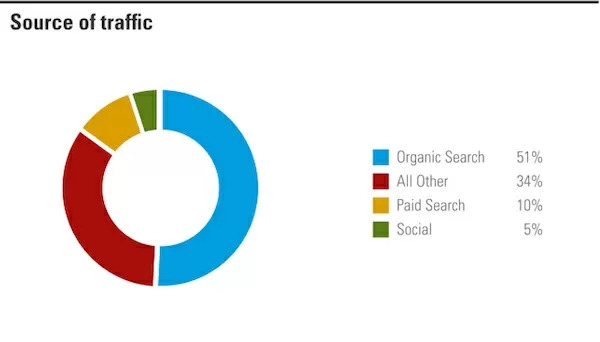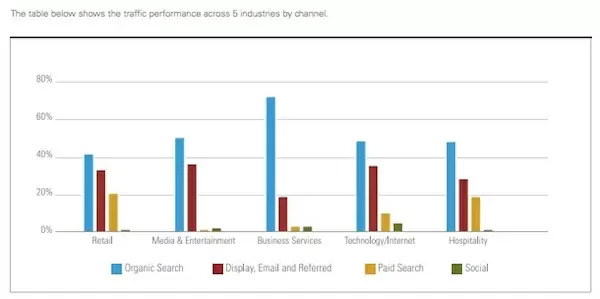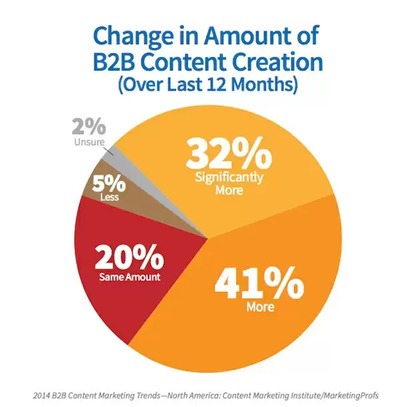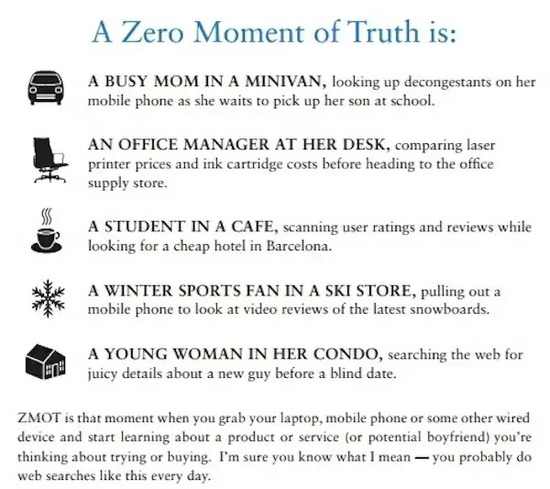The latest findings from the BrightEdge Data Cube released not too long ago show SEO content marketing efforts are paying significant dividends for B2Bs, as measured by both Web traffic and revenue. Specifically, insights from our data repository show that as of August, organic search leads as the primary channel for website organic traffic, driving 51 percent of searchers to sites:

From our report:
All non-organic search channels combined – paid search, social, display, email and referred – don’t stack up to the impact that organic search alone commands across all industries. Search’s dominance may come as no surprise. After all, search has become the dominant user interface to discovering content on the Internet.
Here’s the breakdown of the industry verticals we studied: retail, media and entertainment, business services, technology/internet, and hospitality, and we compared the performance of organic versus non-organic search channels within each sector:

Of the five major industry sectors studied, we found that organic search led in all but one in revenue performance.
As we noted in our report, although organic search clearly drives the most traffic overall, our data support a hybrid approach of organic and paid search for achieving optimum ROI.
B2B brands and SEO content
“Today's business buyers do not contact suppliers directly until 57 percent of the purchase process is complete.” Those words were uttered by Google in its “B2B’s Digital Evolution” article, and they offer real motivation “to influence the 57 percent of the sale that occurs mostly on the Web,” the article states. But it does seem that the B2B sector increasingly embraces not only content marketing, but also content for the organic search channel. According to our findings, the business services (B2B) sector showed organic search was the primary driver of traffic and revenue – above and beyond other sectors studied. And according to other data, like research coming from the Content Marketing Institute’s 2014 B2B Content Marketing report, 93 percent of B2B brands indicated they were implementing content marketing , with 81 percent saying they used articles on their websites and 76 percent indicating they used blogs. The report also highlighted the fact that B2Bs are creating 41 percent more content, with 32 percent citing “significantly more,” than the previous year:

The B2B content marketing challenge
In the “B2B's Digital Evolution” article, Google cites one of the biggest challenges brands face is “matching customer need with channel,” noting the “fragmented approach” most B2Bs take with their content creation efforts. Alluding to its “Zero Moment of Truth” (ZMOT) initiative of delivering the right message to the right person at the right time, the article states that the “challenge for marketers is to be present in these channels at all times with content that educates buyers and helps guide commercial decisions.”

Indeed, Google’s ZMOT is a challenge. As BrightEdge CEO Jim Yu wrote for Marketing Land:
If you’re taking a true content marketing approach, your content should be fueled by data about topics and your audience, then created with a laser focus on relevance and expertise. Distribution of content should be done across multiple channels … Those approaching content marketing without a background in organic search may not understand what it takes for content to compete in what’s arguably among the most profitable online channel.
A future-looking approach to B2B content marketing
Mobile-friendly Web design, semantic markup and rich media (e.g., images and videos) should be content marketing priorities going into 2015. Let’s go over a few of those now.
- Mobile search: Be prepared for the surge in mobile search traffic. The mobile channel is ideal for reaching busy executives and other key decision-makers who often use their tablets or smartphones to research products and services on the fly.
- Semantic search: When Google’s webmaster trends analyst, John Mueller, announced the end of its authorship experiment (covered in detail here), he wrote: “Going forward, we’re strongly committed to continuing and expanding our support of structured markup (such as schema.org). This markup helps all search engines better understand the content and context of pages on the web, and we’ll continue to use it to show rich snippets in search results.” Google’s dedication to semantic search means that adopting structured markup will be essential for your brand’s organic search visibility.
- Rich media: Our Data Cube research (cited above) discovered that rich media – images and videos – amplifies search visibility and drives Web traffic. More compelling still is our finding that videos and images elicit a 13 percent higher click-through rate than written content alone.
As BrightEdge CEO Jim Yu concludes in a recent post for Marketing Land:
Content for the organic search channel has staying power. It can build authority for your brand, and help B2Bs remain a relevant part of the customer’s purchase journey, which often starts with search. As the research shows, B2Bs are embracing content for organic search, and seeing great results. What comes next is refining those strategies, and optimizing the content plan for maximum results in the coming year.

